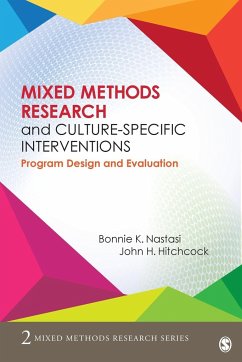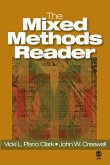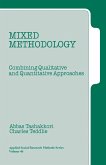Bonnie K. Nastasi, John H. Hitchcock
Mixed Methods Research and Culture-Specific Interventions
Program Design and Evaluation
Bonnie K. Nastasi, John H. Hitchcock
Mixed Methods Research and Culture-Specific Interventions
Program Design and Evaluation
- Broschiertes Buch
- Merkliste
- Auf die Merkliste
- Bewerten Bewerten
- Teilen
- Produkt teilen
- Produkterinnerung
- Produkterinnerung
Mixed Methods Research and Culture-Specific Interventions shows practicing social scientists and graduate students how to account for cultural factors when developing and evaluating psychological and educational interventions using mixed methods research. Providing a methodological basis for handling cultural influences when engaged in intervention and/or evaluation work, the book covers a range of topics, including mixed methods research, program evaluation, ethnography, and intervention design. Throughout the book, authors Bonnie K. Nastasi and John H. Hitchcock integrate illustrative…mehr
Andere Kunden interessierten sich auch für
![SAGE Handbook of Mixed Methods in Social & Behavioral Research SAGE Handbook of Mixed Methods in Social & Behavioral Research]() Abbas TashakkoriSAGE Handbook of Mixed Methods in Social & Behavioral Research175,99 €
Abbas TashakkoriSAGE Handbook of Mixed Methods in Social & Behavioral Research175,99 €![The Mixed Methods Reader The Mixed Methods Reader]() Vicki L. Plano ClarkThe Mixed Methods Reader141,99 €
Vicki L. Plano ClarkThe Mixed Methods Reader141,99 €![Mixed Methodology Mixed Methodology]() Abbas TashakkoriMixed Methodology121,99 €
Abbas TashakkoriMixed Methodology121,99 €![Advances in Mixed Methods Research Advances in Mixed Methods Research]() Advances in Mixed Methods Research71,99 €
Advances in Mixed Methods Research71,99 €![Mixed Methods Social Networks Research Mixed Methods Social Networks Research]() Mixed Methods Social Networks Research115,99 €
Mixed Methods Social Networks Research115,99 €![Innovation in Mixed Methods Research Innovation in Mixed Methods Research]() Cheryl N. PothInnovation in Mixed Methods Research101,99 €
Cheryl N. PothInnovation in Mixed Methods Research101,99 €![Designing and Conducting Mixed Methods Research Designing and Conducting Mixed Methods Research]() John W. CreswellDesigning and Conducting Mixed Methods Research80,99 €
John W. CreswellDesigning and Conducting Mixed Methods Research80,99 €-
-
-
Mixed Methods Research and Culture-Specific Interventions shows practicing social scientists and graduate students how to account for cultural factors when developing and evaluating psychological and educational interventions using mixed methods research. Providing a methodological basis for handling cultural influences when engaged in intervention and/or evaluation work, the book covers a range of topics, including mixed methods research, program evaluation, ethnography, and intervention design. Throughout the book, authors Bonnie K. Nastasi and John H. Hitchcock integrate illustrative examples to make more abstract content accessible. Mixed Methods Research and Culture-Specific Interventions is Volume 2 in the SAGE Mixed Methods Research Series.
Produktdetails
- Produktdetails
- Verlag: Sage Publications, Inc
- Seitenzahl: 224
- Erscheinungstermin: 24. Juni 2015
- Englisch
- Abmessung: 229mm x 152mm x 12mm
- Gewicht: 332g
- ISBN-13: 9781483333823
- ISBN-10: 1483333825
- Artikelnr.: 42318452
- Herstellerkennzeichnung
- Libri GmbH
- Europaallee 1
- 36244 Bad Hersfeld
- gpsr@libri.de
- Verlag: Sage Publications, Inc
- Seitenzahl: 224
- Erscheinungstermin: 24. Juni 2015
- Englisch
- Abmessung: 229mm x 152mm x 12mm
- Gewicht: 332g
- ISBN-13: 9781483333823
- ISBN-10: 1483333825
- Artikelnr.: 42318452
- Herstellerkennzeichnung
- Libri GmbH
- Europaallee 1
- 36244 Bad Hersfeld
- gpsr@libri.de
Bonnie K. Nastasi, PhD (Kent State University, 1986, School Psychology & Early Childhood Education), is Professor of Psychology and Co-director of the Trauma Specialization in School Psychology at Tulane University. She uses mixed-methods research designs to develop and evaluate culturally appropriate assessment and intervention approaches for promoting mental health and reducing health risks, within the United States and internationally. She directed a multi-country study of psychological well-being of children and adolescents with research partners in 12 countries from 2008 to 2013. With colleagues, she developed the Participatory Culture-Specific Intervention Model (PCSIM) to guide the design and evaluation of sustainable culturally and contextually relevant programming through partnerships with stakeholders. She is active in the promotion of child rights and social justice within the profession of school psychology. She is president of the International School Psychology Association.
Editors¿ Introduction
Preface
Acknowledgments
About the Authors
Chapter 1--Introduction: The Role of Culture and Context in Developing
Intervention and Prevention Programs
Introduction
Why Should We Attend To Culture And Context?
Implementation Science and Translational Research
Limitations of Standard Research Approaches and Potential Contributions of
MMR
Overview of the Book's Content and Structure
Conclusion
Key Terms
Reflective Questions and Exercises
References
Chapter 2--Conceptual Models for Mixed Methods and Culture-Specific
Intervention Development
Introduction
Conceptual Models for Intervention Development
MMR Models for Program Development
Key Terms
Reflective Questions and Exercises
References
Chapter 3--Use of MMR to Understand Context and Guide Program Design
Introduction
Ethnography and Associated MMR Practices for Cultural Study and Program
Design
An Illustration
Conclusion
Key Terms
Reflective Questions and Exercises
References
Chapter 4--Use of MMR to Guide Implementation and Adaptation
Introduction
Conceptual and Procedural Foundations
Monitoring Program Implementation
Program Adaptation
Determining Overall Program Success
Capacity for Sustainability and Institutionalization
An Illustration
Conclusion
Key Terms
Reflective Questions and Exercises
References
Chapter 5--Use of MMR to Address Validity Concerns in Program Evaluation
Introduction
Conceptual and Procedural Considerations
Sampling, External Validity, and Transferability Consideration
Pulling it All Together: An Example
Conclusion
Key Terms
Reflective Questions and Exercises
References
Chapter 6--MMR Model Application: A Full Example
Introduction
Contextual and Cultural Considerations
Program Design
Program Implementation and Adaptation
Program Evaluation
Promoting Translation and Capacity Building
Conclusions
Reflective Questions and Exercises
References
Chapter 7--Implementation and Evaluation Challenges
Introduction: Common Challenges in Program Implementation and Evaluation
Establishing and Maintaining Partnerships
Gaining and Maintaining Stakeholder Commitment
Forming Sustainable Decision-Making Teams
Addressing Staff Development Needs
Resource Acquisition and Allocation
Creating Versus Adapting Existing EBIs
Thinking Through MMR Design Quality
Cross-Cultural Social Science Research Has Received Inadequate Attention
Conclusion
Key Terms
Reflective Questions and Exercises
References
Chapter 8--Future Directions
Introduction
Implications for Model Development
Application of MMR to Intervention Development and Evaluation
Implications for Extending Mixed Methodology
Advancing the Science of Intervention Development and Evaluation:
Implications for Implementation Science
Final Thoughts
Reflective Questions and Exercises
References
Index
Preface
Acknowledgments
About the Authors
Chapter 1--Introduction: The Role of Culture and Context in Developing
Intervention and Prevention Programs
Introduction
Why Should We Attend To Culture And Context?
Implementation Science and Translational Research
Limitations of Standard Research Approaches and Potential Contributions of
MMR
Overview of the Book's Content and Structure
Conclusion
Key Terms
Reflective Questions and Exercises
References
Chapter 2--Conceptual Models for Mixed Methods and Culture-Specific
Intervention Development
Introduction
Conceptual Models for Intervention Development
MMR Models for Program Development
Key Terms
Reflective Questions and Exercises
References
Chapter 3--Use of MMR to Understand Context and Guide Program Design
Introduction
Ethnography and Associated MMR Practices for Cultural Study and Program
Design
An Illustration
Conclusion
Key Terms
Reflective Questions and Exercises
References
Chapter 4--Use of MMR to Guide Implementation and Adaptation
Introduction
Conceptual and Procedural Foundations
Monitoring Program Implementation
Program Adaptation
Determining Overall Program Success
Capacity for Sustainability and Institutionalization
An Illustration
Conclusion
Key Terms
Reflective Questions and Exercises
References
Chapter 5--Use of MMR to Address Validity Concerns in Program Evaluation
Introduction
Conceptual and Procedural Considerations
Sampling, External Validity, and Transferability Consideration
Pulling it All Together: An Example
Conclusion
Key Terms
Reflective Questions and Exercises
References
Chapter 6--MMR Model Application: A Full Example
Introduction
Contextual and Cultural Considerations
Program Design
Program Implementation and Adaptation
Program Evaluation
Promoting Translation and Capacity Building
Conclusions
Reflective Questions and Exercises
References
Chapter 7--Implementation and Evaluation Challenges
Introduction: Common Challenges in Program Implementation and Evaluation
Establishing and Maintaining Partnerships
Gaining and Maintaining Stakeholder Commitment
Forming Sustainable Decision-Making Teams
Addressing Staff Development Needs
Resource Acquisition and Allocation
Creating Versus Adapting Existing EBIs
Thinking Through MMR Design Quality
Cross-Cultural Social Science Research Has Received Inadequate Attention
Conclusion
Key Terms
Reflective Questions and Exercises
References
Chapter 8--Future Directions
Introduction
Implications for Model Development
Application of MMR to Intervention Development and Evaluation
Implications for Extending Mixed Methodology
Advancing the Science of Intervention Development and Evaluation:
Implications for Implementation Science
Final Thoughts
Reflective Questions and Exercises
References
Index
Editors¿ Introduction
Preface
Acknowledgments
About the Authors
Chapter 1--Introduction: The Role of Culture and Context in Developing
Intervention and Prevention Programs
Introduction
Why Should We Attend To Culture And Context?
Implementation Science and Translational Research
Limitations of Standard Research Approaches and Potential Contributions of
MMR
Overview of the Book's Content and Structure
Conclusion
Key Terms
Reflective Questions and Exercises
References
Chapter 2--Conceptual Models for Mixed Methods and Culture-Specific
Intervention Development
Introduction
Conceptual Models for Intervention Development
MMR Models for Program Development
Key Terms
Reflective Questions and Exercises
References
Chapter 3--Use of MMR to Understand Context and Guide Program Design
Introduction
Ethnography and Associated MMR Practices for Cultural Study and Program
Design
An Illustration
Conclusion
Key Terms
Reflective Questions and Exercises
References
Chapter 4--Use of MMR to Guide Implementation and Adaptation
Introduction
Conceptual and Procedural Foundations
Monitoring Program Implementation
Program Adaptation
Determining Overall Program Success
Capacity for Sustainability and Institutionalization
An Illustration
Conclusion
Key Terms
Reflective Questions and Exercises
References
Chapter 5--Use of MMR to Address Validity Concerns in Program Evaluation
Introduction
Conceptual and Procedural Considerations
Sampling, External Validity, and Transferability Consideration
Pulling it All Together: An Example
Conclusion
Key Terms
Reflective Questions and Exercises
References
Chapter 6--MMR Model Application: A Full Example
Introduction
Contextual and Cultural Considerations
Program Design
Program Implementation and Adaptation
Program Evaluation
Promoting Translation and Capacity Building
Conclusions
Reflective Questions and Exercises
References
Chapter 7--Implementation and Evaluation Challenges
Introduction: Common Challenges in Program Implementation and Evaluation
Establishing and Maintaining Partnerships
Gaining and Maintaining Stakeholder Commitment
Forming Sustainable Decision-Making Teams
Addressing Staff Development Needs
Resource Acquisition and Allocation
Creating Versus Adapting Existing EBIs
Thinking Through MMR Design Quality
Cross-Cultural Social Science Research Has Received Inadequate Attention
Conclusion
Key Terms
Reflective Questions and Exercises
References
Chapter 8--Future Directions
Introduction
Implications for Model Development
Application of MMR to Intervention Development and Evaluation
Implications for Extending Mixed Methodology
Advancing the Science of Intervention Development and Evaluation:
Implications for Implementation Science
Final Thoughts
Reflective Questions and Exercises
References
Index
Preface
Acknowledgments
About the Authors
Chapter 1--Introduction: The Role of Culture and Context in Developing
Intervention and Prevention Programs
Introduction
Why Should We Attend To Culture And Context?
Implementation Science and Translational Research
Limitations of Standard Research Approaches and Potential Contributions of
MMR
Overview of the Book's Content and Structure
Conclusion
Key Terms
Reflective Questions and Exercises
References
Chapter 2--Conceptual Models for Mixed Methods and Culture-Specific
Intervention Development
Introduction
Conceptual Models for Intervention Development
MMR Models for Program Development
Key Terms
Reflective Questions and Exercises
References
Chapter 3--Use of MMR to Understand Context and Guide Program Design
Introduction
Ethnography and Associated MMR Practices for Cultural Study and Program
Design
An Illustration
Conclusion
Key Terms
Reflective Questions and Exercises
References
Chapter 4--Use of MMR to Guide Implementation and Adaptation
Introduction
Conceptual and Procedural Foundations
Monitoring Program Implementation
Program Adaptation
Determining Overall Program Success
Capacity for Sustainability and Institutionalization
An Illustration
Conclusion
Key Terms
Reflective Questions and Exercises
References
Chapter 5--Use of MMR to Address Validity Concerns in Program Evaluation
Introduction
Conceptual and Procedural Considerations
Sampling, External Validity, and Transferability Consideration
Pulling it All Together: An Example
Conclusion
Key Terms
Reflective Questions and Exercises
References
Chapter 6--MMR Model Application: A Full Example
Introduction
Contextual and Cultural Considerations
Program Design
Program Implementation and Adaptation
Program Evaluation
Promoting Translation and Capacity Building
Conclusions
Reflective Questions and Exercises
References
Chapter 7--Implementation and Evaluation Challenges
Introduction: Common Challenges in Program Implementation and Evaluation
Establishing and Maintaining Partnerships
Gaining and Maintaining Stakeholder Commitment
Forming Sustainable Decision-Making Teams
Addressing Staff Development Needs
Resource Acquisition and Allocation
Creating Versus Adapting Existing EBIs
Thinking Through MMR Design Quality
Cross-Cultural Social Science Research Has Received Inadequate Attention
Conclusion
Key Terms
Reflective Questions and Exercises
References
Chapter 8--Future Directions
Introduction
Implications for Model Development
Application of MMR to Intervention Development and Evaluation
Implications for Extending Mixed Methodology
Advancing the Science of Intervention Development and Evaluation:
Implications for Implementation Science
Final Thoughts
Reflective Questions and Exercises
References
Index









